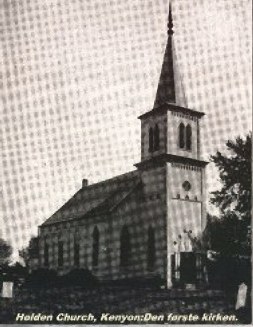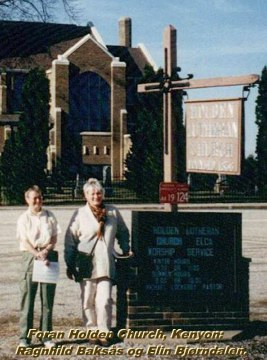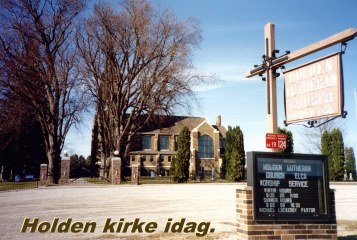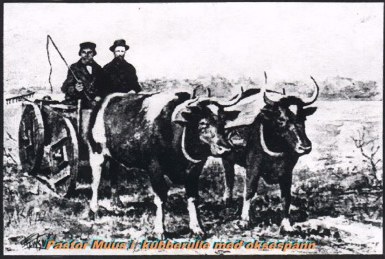Click on the pictures to see in big scale!
|
|
|
|
|
|
|
|
|
( Photos provided by Elin Bjørndalen. )
 In 1853 this county was established by and named after James Goodhue, a lawyer and newspaperman from the East Coast. The area soon became known for its fertile soil, water and woods and for being very picturesque. Most Norwegians settled in the west of Goodhue, and the first to come weren't from Holla but they soon came and gave the name `Holden Township' to the newly-built area. Later, this name was also chosen for a congregation and church in the town. `Holden Academy' was a local high school. It was started by the congregation's first pastor Bernt Julius Muus in 1869 and existed only for a few years. The thread was taken up again in 1874 with a new name - and many are familiar with St.Olaf's College today!
In 1853 this county was established by and named after James Goodhue, a lawyer and newspaperman from the East Coast. The area soon became known for its fertile soil, water and woods and for being very picturesque. Most Norwegians settled in the west of Goodhue, and the first to come weren't from Holla but they soon came and gave the name `Holden Township' to the newly-built area. Later, this name was also chosen for a congregation and church in the town. `Holden Academy' was a local high school. It was started by the congregation's first pastor Bernt Julius Muus in 1869 and existed only for a few years. The thread was taken up again in 1874 with a new name - and many are familiar with St.Olaf's College today!
From the time of the first settlers comes a funny story in the fight over land. Two brothers - Tøge and Henrik Nilsen Talla, originally from Luster in Søgn had decided to take a big piece of the new country. They equipped themselves with an offical-looking document and put up homestead markers with the name Nilsen on to make it clear that this was occupied land - but they did this without official permission! In order to maintain this `claim' one of the brothers equipped himself with a club made of oak and for a whole year this worked very well. However, when a group of immigrants from Telemark arrived led by “Big Sven” Nordgaarden there was trouble! Sven had investigated a large area of the locality and had found that everywhere he went the name `Nilsen' cropped up, so he knew there was mischief afoot. With that, he and his group decided just to settle where they found suitable land. It wasn't long, however, before the Talla brothers turned up with a force of men with sticks to `maintain the law'. However, Sven Nordgaarden went completely beserk and gave them such a beating that they never tried something like it again. Both Norgaarden and the Talla brothers later became members of Holden congregation.....
Holden congregation was established in 1856 and was the first Norwegian congregation in Goodhue. They didn't have a priest for another three years when pastor Muus came. This pastor Muus was a very gifted and energetic man, but also controversial. His first service was held on Ole O. Huset's farm. Before the first church was finished in 1861, all services were held on one or another of the local farms. Amongst others the names Briskemyr and Nils Kvernodden crop up. Other names from Holla were Holtan, Halvor Huset and Kjøstol G. Næseth. Many were people who had moved from the first Holden congregation in Port Washington, Wisconsin.
The area the priest covered was very large - about half the size of Denmark. In one year pastor Muus travelled about 7000 miles by oxen or horse drawn cart, and occasionally on foot! Because of this problem the `parish' was split up into smaller parts: Vang, Dale, Lands, Urland, Hegre, Moland, Gol and Hoff were some of the names with a Norwegian sound.
Gol and Hoff were some of the names with a Norwegian sound.
Pastor Muus was also known for the court case between him and his wife. This was among other things over an inheritance Mrs. Muus received from a relative in Norway. According to Norwegian law in those days the husband had the property rights of any land the woman received. This did not tally with American law. When Oline didn't get the money she thought she was entitled to she took her husband to court. It is easy to imagine a certain unease in the priest's house at that time, and the case ended with both of them living their lives out with separate means.
After a while the first church became too small so in 1934 a new one was built, and this is the building which exists today if you travel to Kenyon in Minnesota.
 In 1853 this county was established by and named after James Goodhue, a lawyer and newspaperman from the East Coast. The area soon became known for its fertile soil, water and woods and for being very picturesque. Most Norwegians settled in the west of Goodhue, and the first to come weren't from Holla but they soon came and gave the name `Holden Township' to the newly-built area. Later, this name was also chosen for a congregation and church in the town. `Holden Academy' was a local high school. It was started by the congregation's first pastor Bernt Julius Muus in 1869 and existed only for a few years. The thread was taken up again in 1874 with a new name - and many are familiar with St.Olaf's College today!
In 1853 this county was established by and named after James Goodhue, a lawyer and newspaperman from the East Coast. The area soon became known for its fertile soil, water and woods and for being very picturesque. Most Norwegians settled in the west of Goodhue, and the first to come weren't from Holla but they soon came and gave the name `Holden Township' to the newly-built area. Later, this name was also chosen for a congregation and church in the town. `Holden Academy' was a local high school. It was started by the congregation's first pastor Bernt Julius Muus in 1869 and existed only for a few years. The thread was taken up again in 1874 with a new name - and many are familiar with St.Olaf's College today!

 Gol and Hoff were some of the names with a Norwegian sound.
Gol and Hoff were some of the names with a Norwegian sound.